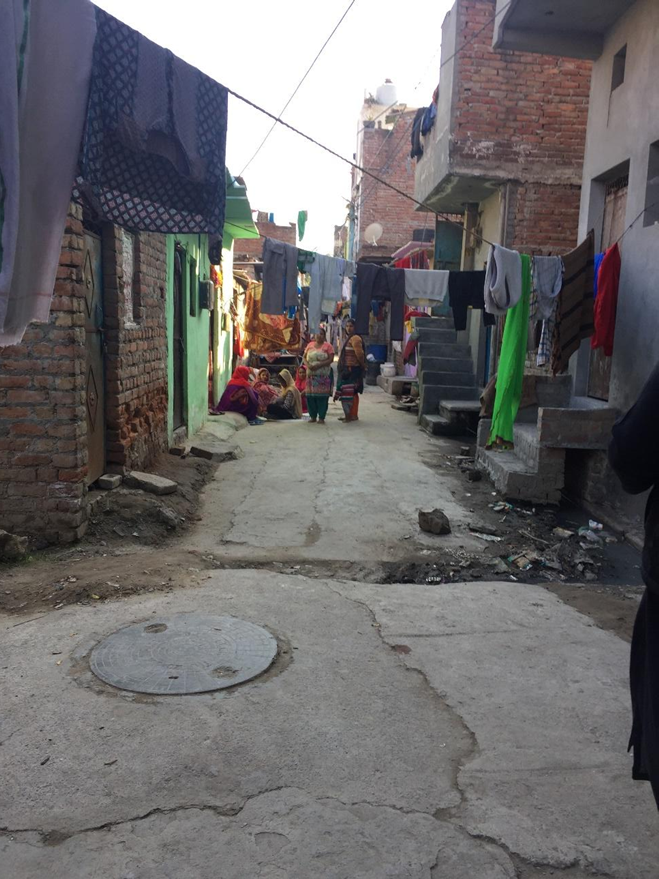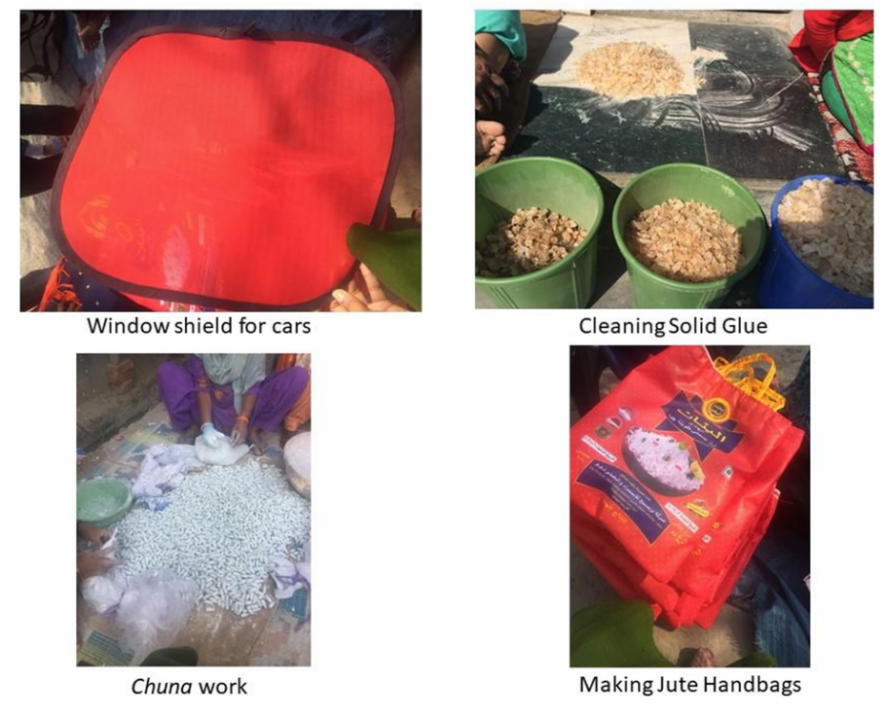Displacement and Livelihood of Industrial Workers on the Periphery of Delhi: Case Study of workers in Narela Industrial Estate

The case study of Narela shows that informal workers exist in a perpetual cycle of precariousness, distress and displacement in a megacity. While this cycle could be broken through interventions in the realms of social provisioning and legislative framework, the State’s policies instead seem to be working towards strengthening this vicious cycle.
This is part of our special issue on May Day 2022.
———
The inflow of migrants into the National Capital Territory [NCT] of Delhi has increased substantially from 8.76 lakhs in 1971 to 22.22 lakhs in 2001 to 72.24 lakhs in 2011, as per the Census of India, 2011. Almost 55.9 percent of total migrants come from rural areas while 38 percent come from urban areas as per NSSO 64th Round, 2007-08. This indicates the pull effect of the metropolitan city in a predominantly agricultural country like India.
The district wise migration data availed from Census 2011 reveals that a large number of migrants in Delhi have been staying here for over twenty years. These old migrants have been occupying the ‘informal’ part of the city for their activities of social reproduction, and have been engaged in the ‘informal’ sector of the economy for employment. Yet in the last two decades, with the changing planning policy of Delhi and the rise of middle-class activism, the old migrants of working-class communities, residing in jhuggis or bastis, have been under a constant threat of coerced displacement.
In the background of implications of reorganization of urban space, this essay highlights the aftermath of the displacement of the working-class to the periphery, with respect to available employment and working conditions of the workers. It uses the case study of a peripheral region of Delhi, called Narela, to show that workers exist in a perpetual cycle of precariousness, distress and displacement in a megacity. While this cycle could be broken through interventions in the realms of social provisioning and legislative framework, the State’s policies instead seem to be working towards strengthening this vicious cycle.
Displacement of working-class population, and relocation of industries
Narela, which is situated in the northern part of Delhi, shares a border with Sonipat district of Haryana. It is located at a distance of about 40 km from centre of Delhi. It was conceived as a place for industrial and population decentralisation in the First Master Plan of Delhi, 1962. Nevertheless it took a Supreme Court Order for Industrial Relocation in 1996 and a large-scale slum demolition drive in Delhi, in the 2000s, to implement such decentralisation.
The initiative of the Delhi government in 2000 and the following few years to relocate slums from the inner city displaced millions of people, who were not resettled but given a plot of land in resettlement colonies, based on eligibility criteria which was determined by the proof of residence before the cut-off date. The resettlement colonies were situated far away from the core of the city, and were without any basic infrastructure required for sustenance.
The displacement was a result of elite middle-class activism, united with planning policies, to remove working-class communities from the otherwise aesthetic part of the megacity on the accounts of ‘illegality’ and ‘criminality’.
The industrial relocation had already destroyed the livelihoods of many workers, and the slum demolition drive had attacked their sites of social reproduction as well. The initiative of the Delhi government in 2000 and the following few years to relocate slums from the inner city- Mandi House, Safdarjung, Nehru Place, ITO, Laxmi Nagar, Yamuna Pushta – displaced millions of people who were not resettled but given a plot of land in resettlement colonies, based on their eligibility criteria which was determined by the proof of residence before the cut-off date. The resettlement colonies were situated far away from the core of the city, and were without any basic infrastructure required for sustenance. Some common sites were Narela, Bawana, Bhalaswa and Madanpur Khadar.
Also read: Nowhere To Go: Khori Gaon Evictions
After independence, the existing major industrial estates were that of Okhla and near Najafgarh area. The relocation order required establishing more industrial estates because the authorities realised that fully equipped industrial estates would be required for industries to move. The industrial estates had mainly small and medium scale industries where physical infrastructure was to be shared by all the industrial units. The industries were certainly not of similar types, but were largely of types which would require semi-skilled or unskilled workers in large numbers where workers would learn the work or gain the skills eventually. Hence, the industrial cluster was formed as a result of planning policies and were not based on initial forces of agglomeration or economies of scale. It was rather dependent on availability of common physical infrastructure and labour power from the available reserve pool of labour.
The factories in industrial estates were heterogeneous in character. The main role of the estate was to offer an incentive to entrepreneurs to take up small scale manufacturing activities and to bring up the collective association of entrepreneurs for an efficient production system. The kind of interconnectedness which is usually seen in these industrial estates is that of management of labour force, and infrastructure through industrial associations and lobbying. The flows of labour from one company to another, where entrepreneurs can draw upon the flexible pool of labour at moments’ notice create a beneficial environment for industries if placed in proximity.
Gendered account of industrialisation in Narela Industrial Estate
After the order of industrial relocation in 1996, the industries had to be given incentives to relocate. The lower land price in Narela was not an adequate incentive to fuel a fully functioning industrial estate. The demolition and resettlement drive in 2000 had shifted the labour to the areas near the industrial estate and hence provided another inducement to the industries — ‘cheap labour’.
After their immediate displacement from the core areas of Delhi as a part of Slum Resettlement Programme, the male workers would commute to old areas for work through public transport facilities provided by the State. However, female workers could not commute to their previous workplaces owing to the factor of distance (which was almost 40-50 km of commute for one side). It was not just ‘looking after household chores’ or responsibility for social provisioning that prevented them to commute; spatial embeddedness to home spaces for female workers, which made them look for jobs in the industries near their place of residence, also played a role. Financial destitution, the need to construct homes on the plot allotted, from scratch, and looking after the family, were the socio-economic conditions which drove women to industrial work, evading the idea of industrial work as inappropriate for females.

A street of Pocket 4 Resettlement Colony in Narela. The colonies, after two decades of resettlement, do not have basic social infrastructure.
After resettlement, during initial days, the female workers started working for wages of Rs. 2,500 per month. Female workers were also taught to work on machinery, yet they were not paid higher wages. Within two or three years after 2000, when new industries began to settle in the Narela Industrial Estate, men also started working there, since commuting to previous places of work took long hours on a daily basis, and new male migrant workers were available for industrial work.
Financial destitution, the need to construct homes on the plot allotted, from scratch, and looking after the family, were the socio-economic conditions which drove women to industrial work, evading the idea of industrial work as inappropriate for females.
As more male workers were available for industrial work, the female workers who had acquired skill for industrial work were either laid off or were hired as helpers. The reasons for this, despite their lower wages as compared to males, were: a) female workers negotiate and are disposed more towards their ‘rootedness’, manoeuvre their ways from one job to another in the Narela Industrial Estate, and sometimes switch to home-based work, hence vigorously negotiating their lives between conflicting positions of housewives and flexibility at work; b) labour contractors, who acted as a bridge between relations of production and relations of social reproduction, played a key role in maintaining familial institution, where breadwinners’ wages were associated with masculinity and the family’s equilibrium.
Low paid and ‘unskilled’ jobs such as stitching, cleaning and packing are given to women so that their bodies are protected, and there is no threat to gender hierarchy within a family. Male workers were paid higher than female workers, but their wages were kept sufficiently low, which squeezed in the females into the workforce.
The traditional patriarchal structures permeated into industrial relations inside industries, which defined the ways of accumulating surplus through exploitation of female labour force. Females were strictly hired to perform low-skilled jobs, even if they were available to learn skills and move up the ladder. Skill is crucial to the language of gendered labour market exclusion. The feminisation of industry and segmented labour markets have been presumed to be a cost-effective strategy for production. Labour contractors had an essential role in orchestrating the gendering of the labour market on the lines of social order that maintains a family.
The industries in Narela Industrial Estate are largely dependent on semi-skilled or unskilled labour. The process of production is based on the hierarchical organisation of workers at a firm. The employer or entrepreneur who owns the factory hires a supervisor, who is responsible for management of the production and workforce. Supervisors, in some cases, were female as well, with at least a higher secondary level of education. In many cases, the employer does not directly come into contact with the workers but depends on labour contractors. There might be four or five permanent labourers on a company’s payroll, registered on paper, who may be in direct contact with the employer.
Interviews with workers revealed that the hours at work, and the wages for the male and female workers varied in industrial firms. Evident wage differences between male and female workers were observed, even for the same work hours. As discussed earlier, female workers were mostly hired as helpers. The average wages for helpers was Rs. 5,000-6,000 per month [pm] for females for 8-10 hours of work a day, and Rs. 6,000-7,500 pm for 8-10 hours and Rs.7,500-9,000 pm for 12 hours for male workers. None of the female workers interviewed worked for more than 10 hours. It was mostly the male workers who would work for 12 hours in a day. Skilled workers would work for 10-12 hours a day and earn Rs. 10,000-15,000 pm. All the skilled workers were male workers.
Low paid and ‘unskilled’ jobs such as stitching, cleaning and packing are given to women so that their bodies are protected, and there is no threat to gender hierarchy within a family.
These male workers had mostly started as helpers and had later learned the job of skilled workers by expressing their interest to the employer/labour contractor. This was mostly observed in the case of male workers; however, none of the female workers interviewed was seen as moving upward in the ladder of skills. Many karigars preferred to work on piece rate wages and earned as much as Rs. 20,000 pm, depending on the working days and hours they put in.
The wages of these workers are far below the minimum wages prescribed by the Labour Department Notification of the Government of NCT Delhi, dated December 7, 2020. The minimum daily wage for an industrial worker per day is Rs. 596 for unskilled workers, while it is Rs. 657-723 for semi-skilled and skilled workers, for working above the ground. However, skilled male workers working at a footwear unit in the Narela Industrial Estate for eight hours would get Rs. 275-300, while a female worker at the same unit would receive between Rs. 215 to Rs. 250 per day.
Also read: Women’s employment amidst a pandemic: What are we missing?
The most common sight while walking through the streets of resettled colonies would be of women sitting outside their homes, on the streets, working. This was piece rate work which engaged various women of resettled colonies. The spatial distribution of the type of work was determined by the contractor, who would distribute the work in a particular pocket. For instance, chuna work, or the task of filling chuna in small bottles for selling at paan shops, was allocated to the ladies of Pockets 8, 10 and 5, while the work of stitching pants, window covers for cars, and jute bags for packing grains was given to ladies of Pocket 13. Such spatial distribution, as told by the women who were working, was majorly based on the connections of the contractor with the people living in the resettlement colonies.

Products of home based work taken by women in resettlement colonies
For filling up 1,000 small bottles with chuna, women workers would get Rs. 100, which amounts to Re. 1 for ten bottles. For making window covers for cars, the contractor offered 35 paise for one piece. The work of cutting bottles for prepping them to fill the product was given at a contract of Rs. 8.50 for one kilogram of bottles. Tying jeans to prepare them for the dyeing process would get each worker Re. 1 for one pair of denims.
A woman from the non-governmental organization Sathi Charitable Trust, came to Pocket 8 through the contact of a police constable, and was offering a respondent to prepare artificial flowers, for which she would be paid at the rate of Re. 1 for 8 flowers. After working incessantly for each day, besides their cooking and cleaning work for the household, women workers were able to earn not more than Rs. 5,000-6,000 per month. This was the maximum limit which could be earned by women workers doing home based work. Negotiating piece rate was also taken up by the male or female heads of the households, in case of young girls or new brides taking up the work, owing to the supposed docility of the younger females.
Despite such low earnings, the women workers took the piece-rate work. It was a choice made out of gendered practices internalised by women, and the comfort of apparent ‘flexibility’ at work. Both these factors are indicative of the entanglements that exist between the relations of social reproduction and relations of production. Women workers would switch between working, looking after children and their other household responsibilities, along with chit-chatting with other women workers in the neighbourhood.
The production system has crept into everyday lives and social reproduction of women workers, without them realising that they are reducing the cost of production. This idea of work and employment in peripheral spaces of cities is governed by the industrial production not being limited to factory spaces, but is also stretched beyond that. It creeps into and spills out to the spaces of social reproduction, and hence makes it essential to realise the bridge between the two.
Despite such low earnings, the women workers took the piece-rate work. It was a choice made out of gendered practices internalised by women, and the comfort of apparent ‘flexibility’ at work. Both these factors are indicative of the entanglements that exist between the relations of social reproduction and relations of production.
The forms of work created in Narela are specific to industrial areas which are largely situated on the margins of the metropolis of Delhi. The labour market then emerges based on the cultural practices existing in a local place, and the women workers tend to negotiate for work and employment within the ambit of their socio-cultural praxis.
Emerging concerns for labour amidst dilution of protective legislation
In response to an application under the Right to Information Act filed by the author in 2019, the Employees’ State Insurance [ESI] Corporation department revealed that about 19,385 workers were employed by 3,139 employers in the Narela industrial Estate. However, labour union members as well as a few workers estimated that there are approximately one lakh workers working in the industrial estate of Narela. This was also corroborated by labour contractors. If it is assumed that these 19,385 workers were permanent/regular workers employed in industries, who could avail ESI benefits, that means that there remain more than 80,000 workers who are not availing any health-related social security. Workers in the Narela Industrial Estate were also not the beneficiaries of any social protection scheme such as provident fund or gratuity.
An estimated 80,000 workers in Narela are not availing any health-related social security.
The contractualisation of jobs to labour contractors and the blurred employer-employee relationship enabled the employers to show the strength of workers engaged at their firms as less than 20, hence removing them from the liability to comply with the Employee Provident Fund [EPF] Scheme, 1952. The employers and labour contractors also revealed in an interview that the lack of documents and the seasonal presence of migrant workers also didn’t do any good to the likelihood or willingness of employers to provide EPF to the workers. Many also dismissed any provision of social security to workers on account of low turnover and profits in the micro and small scale industries.
In this context, it is not a surprise that the industrial workers of Narela Industrial Estate, like other informal workers, were left stranded during the pandemic, after the lockdown. Many workers who were circular/seasonal migrants, living in rental accommodation of urban villages, left for their homes on foot.
The pre-pandemic production regime was seen to be flouting many labour laws, such as the Minimum Wages Act, 1948, the Trade Unions Act, 1926, laws on maternity benefits and gratuity, the Industrial Establishments (Standing Orders) Act, 1946, and the Factories Act, 1948. Amidst the major crisis of social reproduction amongst working-class families, the pandemic witnessed several state governments redefining labour laws, including by extending ‘hours of work’. The Uttar Pradesh government, with a short ordinance, sought to annul all but three labour legislation.
The Industrial Relations Code, 2020 [IRC], one of the four new labour codes aimed at consolidating central labour laws, aims to promote the ease of doing business and spur investment by encouraging labour flexibility. A critical examination of the Code suggests that it will fail to create a conducive and efficient industrial relations environment, and will neither promote ease of doing business nor serve workers’ welfare. IRC also dilutes the provisions for legal strike. The Industrial Disputes Act, 1947 was formulated to ensure employee’s welfare, while in the new Code, focus has shifted towards ease of business.
A high number of accidents are reported in Narela Industrial Estate because of poor safety precautions and lack of protective gears used in the industries to reduce production costs. In almost all cases, no legislative framework was followed, and workers were given some small compensation. In such cases, the Occupational Safety, Health and Working Conditions Code, 2019 [OSHWCC] provides narrow coverage, and leaves out the vast majority of economic establishments, including those in the unorganised sector, that is, those employing less than ten workers.
Also read: Report on worker safety in Indian auto sector presents a despairing state of affairs
According to the Sixth Economic Census, establishments employing ten or more workers accounted for only 1.66 per cent of the total establishments in the non-agricultural sector. Therefore, such low coverage by the OSHWCC leaves the large majority of workers more vulnerable, with IRC ripping off their rights to strike and approach courts. Even the Wage Code, 2019 disturbs the existing framework of legal provision to ensure minimum wages for workers across sectors by taking away the jurisdiction of courts in case of violation of minimum wage rights, without providing any credible structure for addressing the concern.
The Social Security Code, 2020 fails to address the protection of home-based workers, agricultural labourers and domestic workers yet again. It missed the opportunity to formulate legal provisions which would easily and fully cover the working class population with easy transaction cost and implementation mechanisms.
A few interviewed workers revealed that just after the lockdown was lifted, many of them had to join the night shift because their employers were still sceptical about running the factory with full capacity during day hours.
Women workers in resettlement colonies who relied on home-based work outsourced to them by the contractors of the nearby factories, had no work for almost a year. Borrowing from informal channels at high interest rate was common amongst workers during this period, further pushing them into a cycle of debt, and often tied labour with the quid pro quo principle. In such a background, a weak legislative framework only undermines workers’ bargaining position even more in the labour market.
Also read: In Delhi’s Industrial Areas, Paltry Savings of Workers Dry Up in Lockdown
The case study of Narela Industrial Estate shows that the process of industrialisation took advantage of urban planning policies which were ignorant of migrant workers’ lives and their livelihoods. The policy of resettlement and relocation has given rise to a gendered account of industrial development in which rural socio-cultural practices are embedded in urban industries. The planning policies destroyed the site of social reproduction of workers, which made them more vulnerable and reduced their bargaining position in the industrial estate. This consequently escalated the agglomeration of industries in the estate.
The Occupational Safety, Health and Working Conditions Code, 2019 leaves out the vast majority of economic establishments, including those in the unorganised sector, that is, those employing less than ten workers. According to the Sixth Economic Census, establishments employing ten or more workers accounted for only 1.66 per cent of the total establishments in the non-agricultural sector. Therefore, such low coverage by the Code leaves the large majority of workers more vulnerable.
The current weakening of the legislative framework for workers further pushes them to the margins, making it more difficult for unions to organise industrial workers in small and micro scale industries. Therefore, it becomes important to understand the entanglement of production and social reproductive processes, and organise workers on those lines to claim their working and living rights in the city.
Dr. Tanya Chaudhary is an Associate Fellow at Institute for Human Development. She has completed her Ph.D degree from the School of Development Studies, Ambedkar University, Delhi.
Get the latest reports & analysis with people's perspective on Protests, movements & deep analytical videos, discussions of the current affairs in your Telegram app. Subscribe to NewsClick's Telegram channel & get Real-Time updates on stories, as they get published on our website.
























